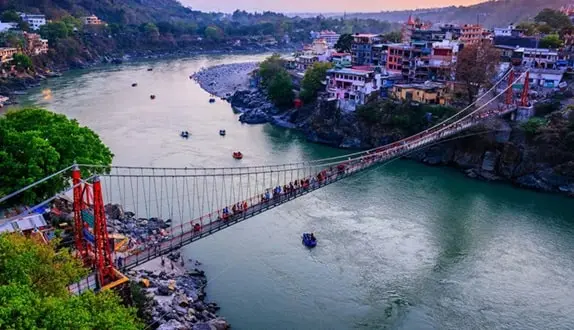India is blessed with a rich network of rivers that play a crucial role in the country’s culture, economy, and ecology. These rivers have nurtured civilizations for thousands of years, providing water for drinking, agriculture, and transport. They are also deeply woven into the spiritual and religious fabric of the nation. In this article, we will explore the top 10 famous rivers in India, ranked according to their current popularity and significance.
1. Ganga (Ganges)

The Ganga, or Ganges, is undoubtedly the most famous river in India. Flowing through northern India, it is considered sacred by millions of Hindus. The river originates from the Gangotri Glacier in Uttarakhand and travels approximately 2,525 kilometers before emptying into the Bay of Bengal.
The Ganga is not only vital for drinking water and agriculture but is also the site of many religious rituals. Pilgrims from all over the country visit the Ganga to perform puja (prayers) and immerse the ashes of their loved ones. The river’s spiritual significance and its historical role make it the most popular river in India.
2. Yamuna
The Yamuna River is the second most significant river in India and is a tributary of the Ganga. It originates from the Yamunotri Glacier in Uttarakhand and flows through several states, including Delhi, Haryana, and Uttar Pradesh, before joining the Ganga at Allahabad (Prayagraj).
The Yamuna is famous for its cultural and historical importance, particularly due to the Taj Mahal, which is located on its banks in Agra. Despite its beauty, the Yamuna faces severe pollution challenges, especially in urban areas. Nonetheless, its historical and cultural significance keeps it popular among the people.
3. Brahmaputra
The Brahmaputra River is one of the major rivers in India, originating from Tibet and flowing through the northeastern states of Arunachal Pradesh, Assam, and West Bengal before entering Bangladesh. It is approximately 2,900 kilometers long and is known for its vast basin and fertile floodplains.
The Brahmaputra is significant for its biodiversity and the unique culture of the communities living along its banks. It is also vital for agriculture and fishing in the region. The annual floods enrich the soil, making it suitable for farming. The river’s beauty and cultural importance make it one of the most popular rivers in India.
4. Godavari
The Godavari River is the second-longest river in India, flowing for about 1,465 kilometers. It originates in the Western Ghats of Maharashtra and flows through the states of Telangana, Andhra Pradesh, Chhattisgarh, and Odisha before reaching the Bay of Bengal.
The Godavari is often referred to as the “Ganga of the South” and is crucial for irrigation and agriculture. Many festivals are celebrated along its banks, attracting thousands of devotees. The river’s cultural significance and economic role in southern India enhance its popularity.
5. Krishna
The Krishna River is another important river in southern India, originating in the Western Ghats of Maharashtra. It flows for about 1,300 kilometers through Karnataka, Andhra Pradesh, and Telangana before meeting the Bay of Bengal.
The Krishna River is vital for irrigation and hydroelectric power generation. Many ancient temples and cultural sites are located along its banks, making it a significant river for local communities. Its importance in agriculture and cultural heritage contributes to its popularity.
6. Narmada
The Narmada River is one of the major rivers in central India, flowing for approximately 1,312 kilometers. It originates from the Amarkantak Plateau in Madhya Pradesh and flows through Maharashtra and Gujarat before emptying into the Arabian Sea.
The Narmada is famous for its picturesque landscapes and is often referred to as the “Lifeline of Madhya Pradesh.” It is also known for the Narmada Valley Project, which has contributed significantly to irrigation and power generation. The natural beauty and economic importance of the Narmada make it popular among locals and tourists.
7. Tapi (Tapti)
The Tapi River is another important river in central India, flowing parallel to the Narmada. It originates in the Satpura Range of Madhya Pradesh and flows through Maharashtra and Gujarat before meeting the Arabian Sea. The river is approximately 724 kilometers long.
The Tapi is known for its scenic beauty and is vital for irrigation and drinking water supply in the regions it traverses. It is also famous for the ancient temples located along its banks. The river’s charm and cultural significance contribute to its popularity.
8. Mahanadi
The Mahanadi River flows through central and eastern India, covering approximately 851 kilometers. It originates in the state of Chhattisgarh and flows through Odisha before emptying into the Bay of Bengal.
The Mahanadi is crucial for irrigation and agriculture in the region, supporting millions of farmers. It is also famous for the annual Mahanadi River Festival, which attracts many visitors. The river’s significance in agriculture and its vibrant cultural activities keep it popular among the people.
9. Saraswati
The Saraswati River is considered a sacred river in Hindu mythology, although it is not a major river in terms of length or water flow. It is believed to be a seasonal river that flows through northwestern India, particularly in the regions of Haryana and Punjab.
While the Saraswati may not have the same physical presence as other rivers, its cultural and spiritual importance cannot be underestimated. It is often associated with knowledge, learning, and wisdom. The river holds a special place in Indian mythology, which keeps it alive in the hearts of many.
10. Ganga Ghaghara
The Ghaghara River, a major tributary of the Ganga, originates in the Tibetan region and flows through the Indian states of Uttarakhand and Uttar Pradesh. It is approximately 507 kilometers long and is known for its seasonal floods, which enrich the surrounding plains.
The Ghaghara is significant for agriculture and local communities who rely on its waters. While it may not be as famous as the Ganga, its contribution to the ecosystem and the livelihoods of people living nearby makes it an important river.
Conclusion
These top 10 famous rivers in India have not only shaped the geography of the country but have also played a vital role in its culture, economy, and ecology. From the sacred Ganga to the picturesque Narmada, each river has its unique significance and charm.
Their importance goes beyond just being sources of water; they are lifelines for millions of people and are deeply woven into the cultural fabric of India. As we continue to face challenges like pollution and climate change, it is essential to preserve and protect these rivers for future generations. The rivers of India are not just water bodies; they are symbols of life, culture, and history.

